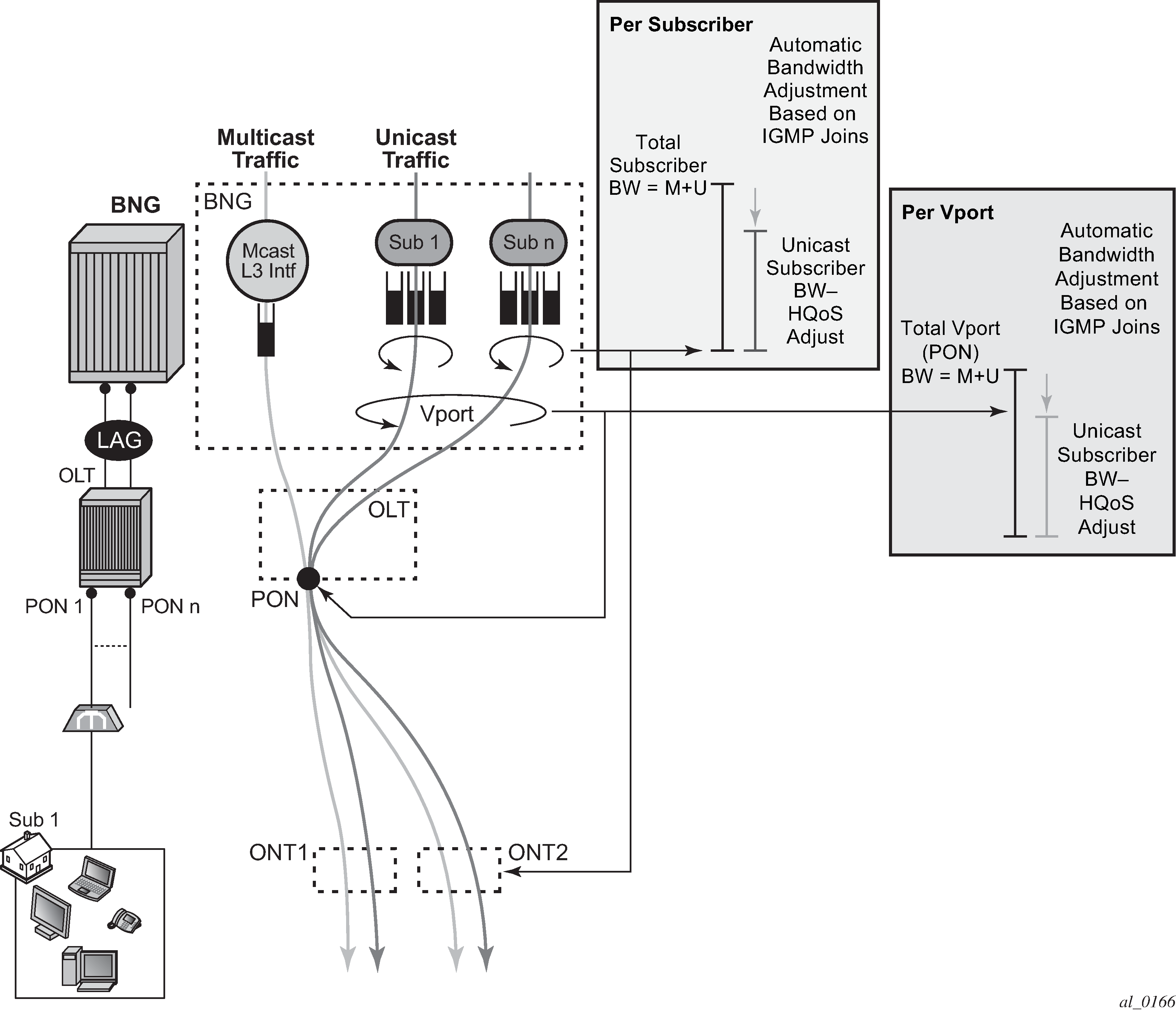HQoS adjust per Vport can be used in environments where Vport represents a physical medium over which traffic for multiple subscribers is shared. Typical example of this scenario is shown in Figure: HQoS adjustment per subscriber and Vport. Multicast traffic within the router is taking a separate path from unicast traffic, only for the two traffic flows to merge later in the PON (represented by a Vport) and ONT (represented by the subscriber in the 7450 ESS and 7750 SR).

A single copy of each channel is replicated on the PON as long as there is at least one subscriber on that PON interested in this channel (has joined the IGMP/MLD group).
The 7450 ESS and 7750 SR monitors IGMP/MLD Joins at the subscriber level and consequently the channel bandwidth is subtracted from the current Vport rate limit only in the case that this is the first channel flowing through the corresponding PON. Otherwise, the Vport bandwidth is not modified. Similarly, when the channel is removed from the last subscriber on the PON, the channel bandwidth is returned to the Vport.
Association between the Vport and the subscriber is performed by an inter-destination-string or svlan during the subscriber setup phase. An inter-destination-string can be obtained either by RADIUS or LUDB. If the association between the Vport and the subscriber is performed based on the svlan (as specified in sub-sla-mgmt under the SAP or MSAP), then the destination string under the Vport must be a number matching the svlan.
The mcac-policy (channel definition bandwidth) can be applied on the group interface under which the subscribers are instantiated or in case of redirection under the redirected-interface.
In a LAG environment, the Vport instance is instantiated per member LAG link on the IOM. For accurate bandwidth control, it is prerequisite for this feature that subscriber traffic hashing is performed per Vport.
The CLI structure is as follows.
configure
port <port-id>
ethernet
access
egress
vport <name>
egress-rate-modify
agg-rate
host-match <destination-string>
port-scheduler-policy <port-scheduler-policy-name>
configure
port <port-id>
sonnet-sdh
path [<sonnet-sdh-index>]
access
egress
vport <name>
egress-rate-modify
agg-rate
host-match <destination-string>
port-scheduler-policy <port-scheduler-policy-name>
The Vport rate that is affected by this functionality depends on the configuration:
When the agg-rate-limit within the Vport is configured, its value is modified based on the IGMP activity associated with the subscriber under this Vport.
When the port-scheduler-policy within the Vport is referenced, the max-rate defined in the corresponding port scheduler policy is modified based on the IGMP activity associated with the subscriber under this Vport.
The Vport rates can be displayed with the following two commands:
- show port 1/1/5 vport name
- qos scheduler-hierarchy port port-id vport vport-name
As an example:
*A:system-1# show port 1/1/7 vport
========================================================================
Port 1/1/7 Access Egress vport
========================================================================
VPort Name : isam1
Description : (Not Specified)
Sched Policy : 1
Rate Limit : Max
Rate Modify : enabled
Modify delta : -14000
In this case, the configured Vport aggregate-rate-limit max value has been reduced by 14 Mb/s.
Similarly, if the Vport had a port-scheduling-policy applied, the max-rate value configured in the port-scheduling-policy would have been modified by the amount shown in the Modify delta output in the above command.